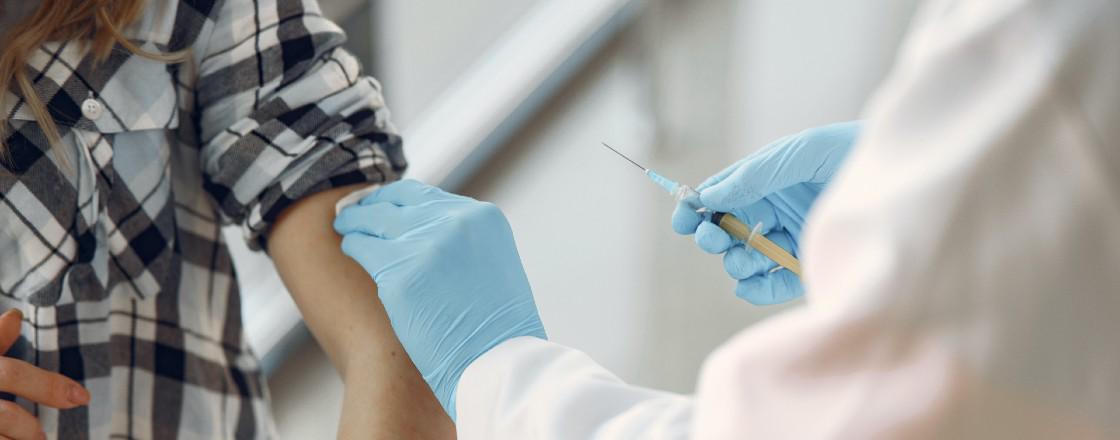Using the COVID-19 Symptom Survey to Track Vaccination Uptake and Sentiment in the United States

The COVID-19 Symptom Survey, which is conducted by the Delphi Group in partnership with Facebook Data for Good, is one of the largest COVID-19 data collection efforts in the United States. To date, over 16 million responses have been collected since its launch in April 2020. Using the Symptom Survey, we have been able to track and inform trends on daily symptoms, testing, mask-wearing, social distancing, mental health, and more across the U.S. Check out our dashboard to see how our data can support your community needs and check out the international version conducted internationally in 200+ countries and territories in 55+ languages by our partner, the University of Maryland.
We encourage researchers, public health officials, and the public to use the survey data and tools available. Public, aggregate data is available through Carnegie Mellon University’s API for the US and through University of Maryland’s API for the global survey. Microdata is also available upon request to academic and nonprofit researchers under data usage agreements to protect the confidentiality of responses.
New Vaccine Surveillance Module
In support of the COVID-19 vaccination campaigns that are currently underway across the country, we collaborated with the U.S. Centers for Disease Control and Prevention (CDC) to incorporate several vaccine surveillance questions that enable our survey to track vaccination uptake and measure vaccine-related sentiments as the states plan and progress through the different phases of the federal priority criteria and their own vaccination programs. We aimed to address the following critical public health topics:
How many people are vaccinated? Of those who are vaccinated, how many received the complete set of doses?
How many people are hesitant about getting vaccinated? Why? How many are worried about experiencing a side effect?
Are there barriers to accessing either vaccinations or information about vaccinations?
Would people be more likely to get vaccinated if it were recommended to them by certain information sources?
How do the responses to these questions vary by sociodemographic status such as occupation, age, gender, and race or ethnicity? How do these vary by clinical risk factors?
Though a few of these questions are not yet incorporated into our survey, the Symptom Survey now includes daily responses that can be used to answer many of these questions. The other items will be incorporated soon, so stay tuned and check back here!
Insights from the Symptom Survey’s COVID-19 Vaccination Data
As COVID-19 vaccination programs ramp up across the country, we can use data from the Symptom Survey to estimate percentages of individuals who report having been vaccinated. We used 300,000 survey responses received between January 9th and January 15th to calculate the percentage of respondents in each state who say they have received a COVID-19 vaccination, shown below:
The map suggests that the estimated proportion of individuals vaccinated is highest in some states in the midwestern, southern, and northeastern regions, which is a similar pattern to what is shown in CDC vaccine dose administration data. Alaska and West Virginia also stand out with some of the highest per capita self-reported vaccination rates.
This signal may differ from CDC data on vaccine administration across the U.S. because of survey biases combined with lag in official reporting and should not be treated as authoritative. We will continue to assess these biases as we collect more data. To establish confidence in the insights from the survey, we conducted a simple correlation analysis between the most recently available survey data and the official CDC vaccine data. We found a correlation of 0.83 between the survey’s self-reported vaccine uptake and the CDC’s reported number of people with 1+ doses per 100K. This gives confidence that the survey aligns with official data and that the unique, granular insights showcased match reality.
One of the unique values of our survey is that we are able to further break down the percentages by population subgroups, such as various race and ethnicity groups, which is important for policymakers to consider given the health and vaccination disparities that exist by race and ethnicity. In the figures below, we illustrate how self-reported vaccination rates vary by racial and ethnic groups.
There seems to be a large variation in self-reported vaccination by race and ethnicity: We observe the highest rates among Asians and American Indians or Alaska Natives, and the lowest rates among the Black or African American group. The high uptake among American Indians or Alaska Natives is particularly noteworthy, as it corroborates the efficient widespread vaccination rollouts by the Indian Health Service.
We are also able to further examine disparities across the states in our data. Below, we illustrate how self-reported vaccination rates for Black individuals compare to White individuals:
While we are not currently able to make comparisons for all states due to a small sample size of Black respondents in several states that prevents aggregate reporting, we observe that for most of the remaining states, the estimated percentages of vaccinations are lower among Black adults compared to White adults, with most states showing a relative ratio less than 1, meaning a lower likelihood of self-reported vaccinations among Black adults compared to White adults. As we make comparisons using these data, we should acknowledge that vaccinations are currently being prioritized among healthcare workers and older individuals, so the trends that we observe today may not necessarily be what we observe once vaccinations reach other population groups.
Vaccine Uptake Among Priority Groups
State and local health authorities are currently allocating the COVID vaccine first to certain priority groups, taking into consideration recommendations by the CDC and the Advisory Committee on Immunization Practices. For most states, the priority groups currently include healthcare workers and those over age 65 or 75.
Using survey responses from early January, we used the Symptom Survey to examine estimated vaccination rates among healthcare workers and people age 65 and older. For several months, the survey has been asking a few questions related to occupation, so we classified respondents as healthcare workers if they indicated that their job can be categorized as either “healthcare practitioner or technician” or “healthcare support”. (This includes, doctors, nurses, pharmacists, dentists, technicians, and many related fields.) Below, we depict 1) self-reported vaccination rates among the priority groups, 2) differences in the percentages by gender, and 3) differences in the percentages by race and ethnicity groups.
Self-reported vaccination rates are higher among healthcare workers than among individuals aged 65+ years, which is reasonable given that they were the first group to be given priority. When comparing by gender, the proportions are slightly higher for men compared to women, and this difference is more prominent among healthcare workers.
We also notice a consistent trend in self-reported vaccination rates when broken down by race and ethnicity: the rate among the Black or African American group is consistently lower than other groups such as White and Asian. This is consistent with research on health disparities during the COVID pandemic and many years of disparities long before it, highlighting the importance of actions to reduce disparity in healthcare and access.
(Note that when a race and ethnicity group is missing in the figures, it does not necessarily indicate the absence of the group among our respondents; it is more likely that there are too few responses among that group for aggregated reporting in a given area.)
Vaccine Acceptance
There are still many who have not yet received a vaccination in the U.S., including among priority groups. This raises the question: of those not yet vaccinated, how many are willing to receive a COVID-19 vaccination? We mapped the estimated proportion of vaccine acceptance, which is defined here as definitely or probably choosing to receive a COVID-19 vaccination if it were offered to them today.
We find that in most states, the majority of people are vaccine-accepting, and that the highest acceptance rates are observed in states in the western, midwestern, and northeastern regions (see figure below). While researchers are not yet certain about the proportion of the population that should be vaccinated to reach herd immunity against COVID-19, our data on vaccine acceptance and uptake still provide valuable insights into where and who we can better target to improve vaccine-related sentiments.
Similar to what we have observed with self-reported vaccination rates, our data depict a wide range of vaccine acceptance by race and ethnicity groups (shown below). This disparity is similar to what has been seen previously for other vaccines, and is likely the result of many factors: in particular, in the United States, minority groups are less likely to have affordable access to healthcare, and decades of discriminatory treatment have reduced their trust in medicine.
Increasing the Likelihood of Vaccination
Our new survey data shows not only the prevalence of self-reported vaccination uptake and acceptance, but also how we may be able to improve vaccination-related messaging. One of the questions that we ask on our survey is, “Would you be more or less likely to get a COVID-19 vaccination if it were recommended to you by each of the following? Friends or family, local healthcare providers, World Health Organization (WHO), politicians, or government health officials” (adapted from the MIT COVID-19 Survey).
With this information, we are able to examine which of the five sources of information may be trusted more by individuals who have not yet reported getting vaccinated. Below, we break down the responses by two groups of respondents: those who are vaccine-accepting (i.e., indicated that they are definitely or probably choosing to get vaccinated) and those who are vaccine-hesitant (i.e., indicated that they are definitely not or probably not choosing to get vaccinated).
Interestingly, but perhaps not surprisingly, there seems to be a large difference in responses between the vaccine-accepting and vaccine-hesitant groups. We find that among individuals who have not yet been vaccinated (self-reported), those who are vaccine-hesitant are much less likely to get vaccinated based on recommendations in general compared to the vaccine-accepting group.
Among those who are vaccine-accepting, they are more likely to get vaccinated if the recommendations come from more authoritative sources like the World Health Organization (WHO), local healthcare workers, or government health officials. Those who are vaccine-hesitant are less likely to report that they would get vaccinated in general; however, they also seem to trust their local healthcare workers the most as a vaccine-related information source. Interestingly, this group is also more likely to take recommendations from friends or family members than from the WHO or government health officials. Taken together, our results can be used to inform how policymakers and health organizations should leverage various information sources in future messaging campaigns to potentially increase vaccine acceptance and ultimately, vaccine uptake.
Concerns About Side Effects
To improve and sustain high vaccination rates, it will also be critical to understand potential barriers to uptake or reasons for vaccine hesitancy. One major barrier may be concerns related to side effects, and we can track the percentages of those who may be concerned about side effects using one of our newly-added questions: “How concerned are you that you would experience a side effect from a COVID-19 vaccination?”
When we examine the state-level estimated percentages (shown in the figure below), we find that the proportion of those who are very or somewhat worried about side effects vary from 30% to 50% in the U.S., and we observe the highest rates concentrated in the South.
Based on our earlier results demonstrating differences in vaccination rates and acceptance by race and ethnicity, we also illustrate below how concerns about side effects compare between Black and White adults.
In all of the states with adequate survey sample sizes for both Black and White respondents, we find that Black individuals are consistently more likely to worry about experiencing a side effect compared to White individuals, as indicated by relative ratios that are greater than 1 (meaning a higher likelihood of worrying about a side effect). In fact, in some states, this ratio reaches 2, which means that Black adults are twice as likely to worry about experiencing a side effect compared to White adults When we further break down this comparison by vaccine acceptance/hesitancy (see the figure below), we find that Black individuals are always more likely to be concerned about experiencing side effects compared to White individuals, regardless of being vaccine-accepting or vaccine-hesitant. Future research is warranted to better understand how we can address these concerns in various subpopulation groups and if addressing concerns related to side effects can lead to higher vaccination rates.
How You Can Analyze This Data
In this post, we provided an introduction and an overview of the vaccination-related data that are available in the COVID Symptom Survey and how we can use the data to answer important public health questions related to vaccinations. There are, however, many more questions that you can help answer. For example, how do self-reported vaccinations and vaccination-related sentiments change over time? How do these change in response to guidelines and public health interventions? Is vaccine hesitancy associated with other behavioral measures or social activities? How is your local community responding to all of the vaccination-related efforts? You can answer all of these and more by analyzing these data!
To get started, check out our interactive map and survey dashboard to play with the data. Then dive into our documentation on the COVID Symptom Survey. County and state-level aggregates are available publicly through the Delphi Group’s COVIDcast API. In the coming weeks we plan to release additional aggregates, including many of the demographic breakdowns you’ve seen above, as data files for public research use. (These will only contain aggregated data, not individual survey responses.) Academic and non-profit researchers can also request access to the microdata.
For those interested, you can also read about the international Symptom Survey, which is conducted by our partner the University of Maryland in over 200 countries and territories worldwide.
Privacy Statement
This survey was designed with privacy in mind from the start. Carnegie Mellon University and the University of Maryland do not share individual survey responses with Facebook, and while Facebook recruits participants to the survey, participants can’t be linked back to their Facebook profiles. When non-aggregated survey data is shared with eligible academic and nonprofit institutions, Facebook shares a single statistic known as a weight value, which doesn’t identify a person but helps researchers correct for any sample bias. This helps ensure that the survey sample more accurately reflects the characteristics of the population represented in the data.
Acknowledgements: Facebook’s team, including Kelsey Mulcahy, Katherine Morris, Leanna Morinishi, Kris Barkume, Sid Palani, and Patrick Xu, assisted with the analysis and writing of this post. At Carnegie Mellon, Wichada La Motte-Kerr assisted in the development and deployment of many of these survey questions.
Related Posts:

